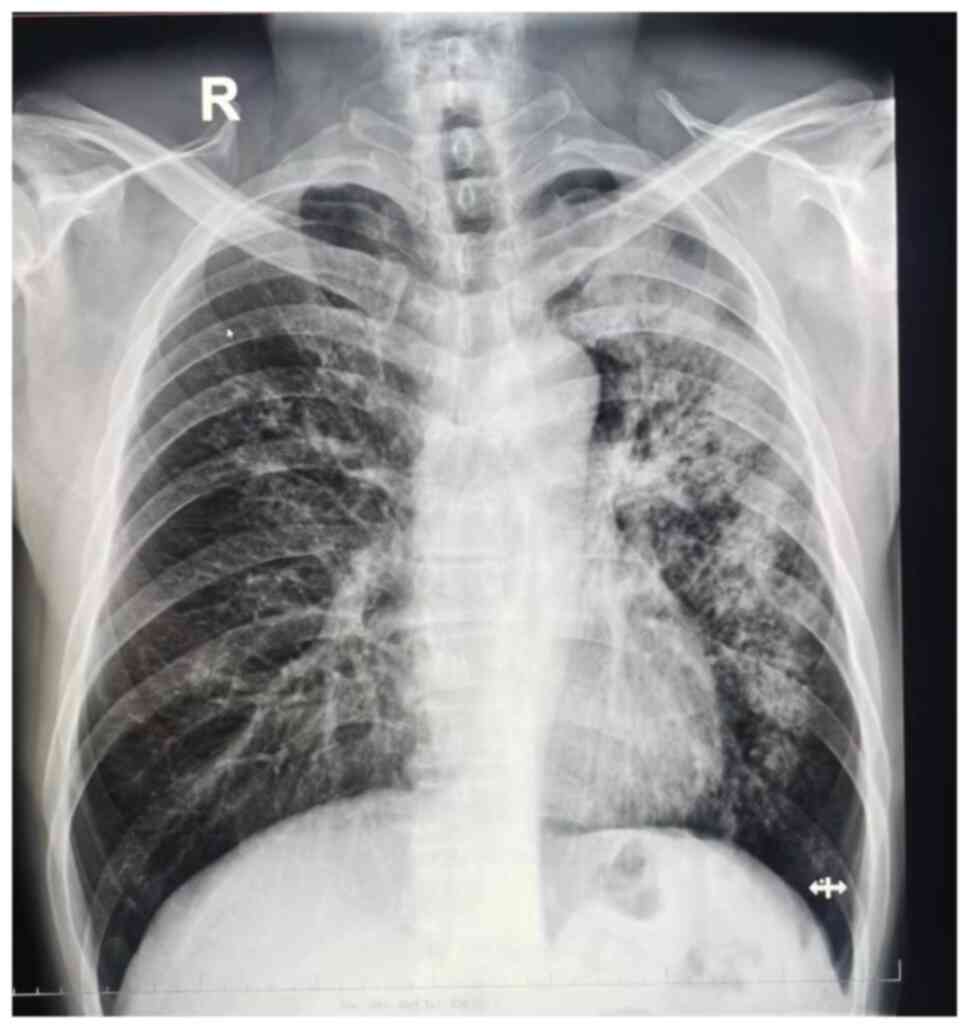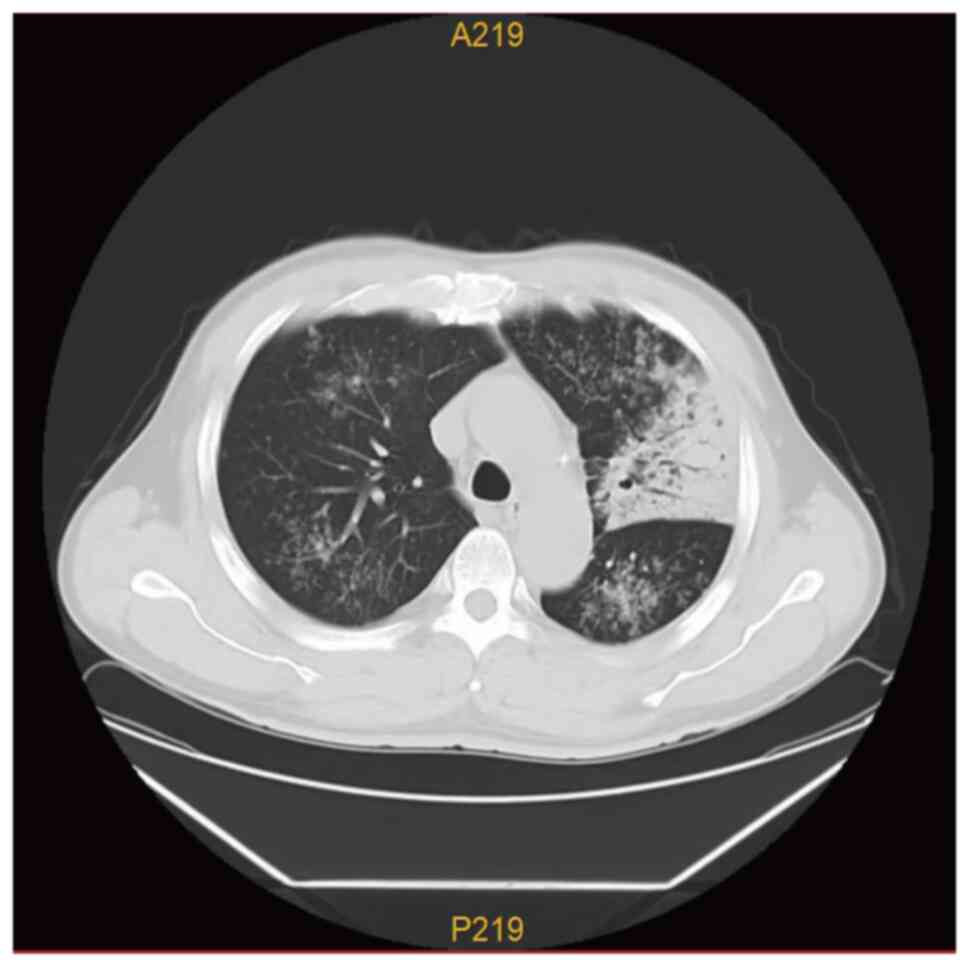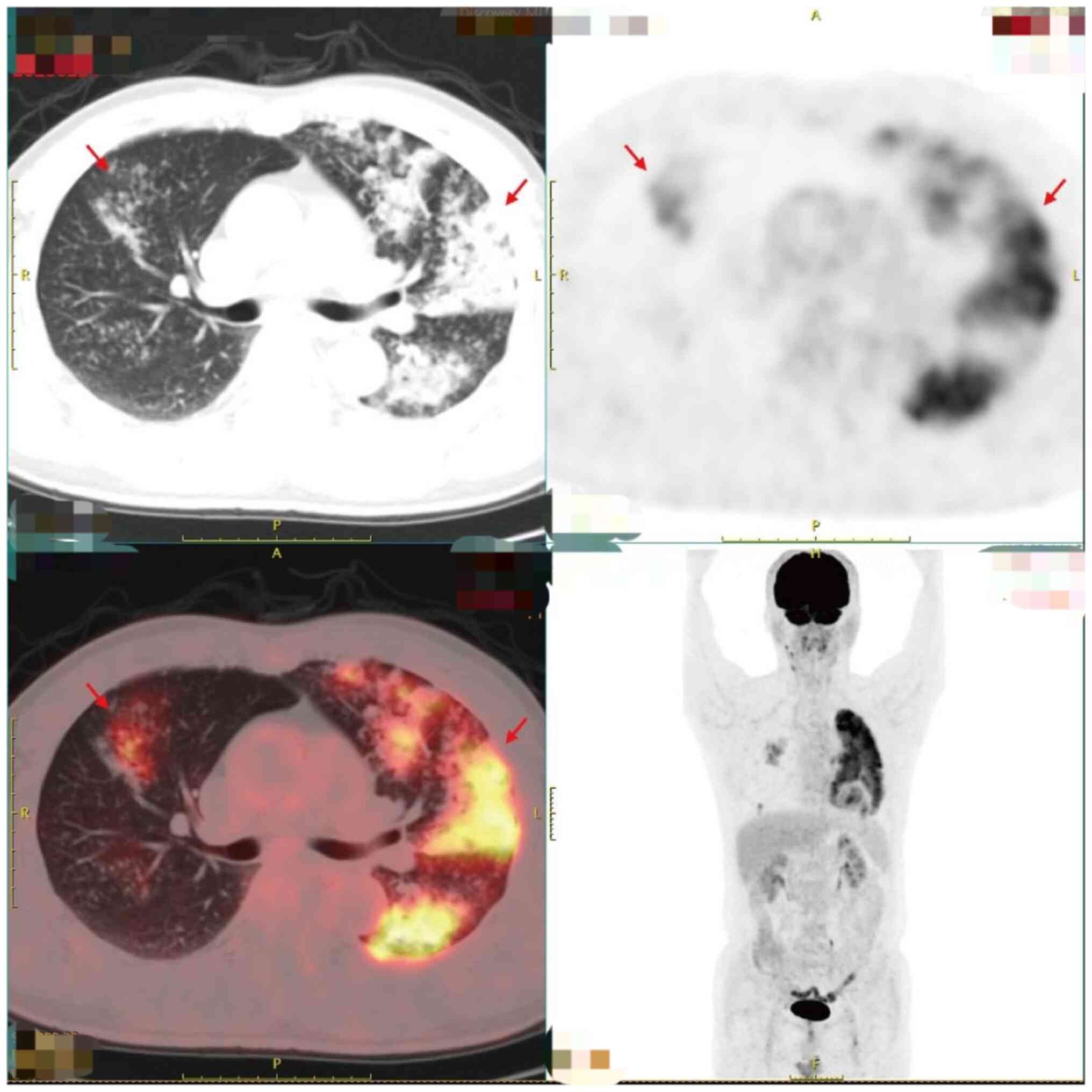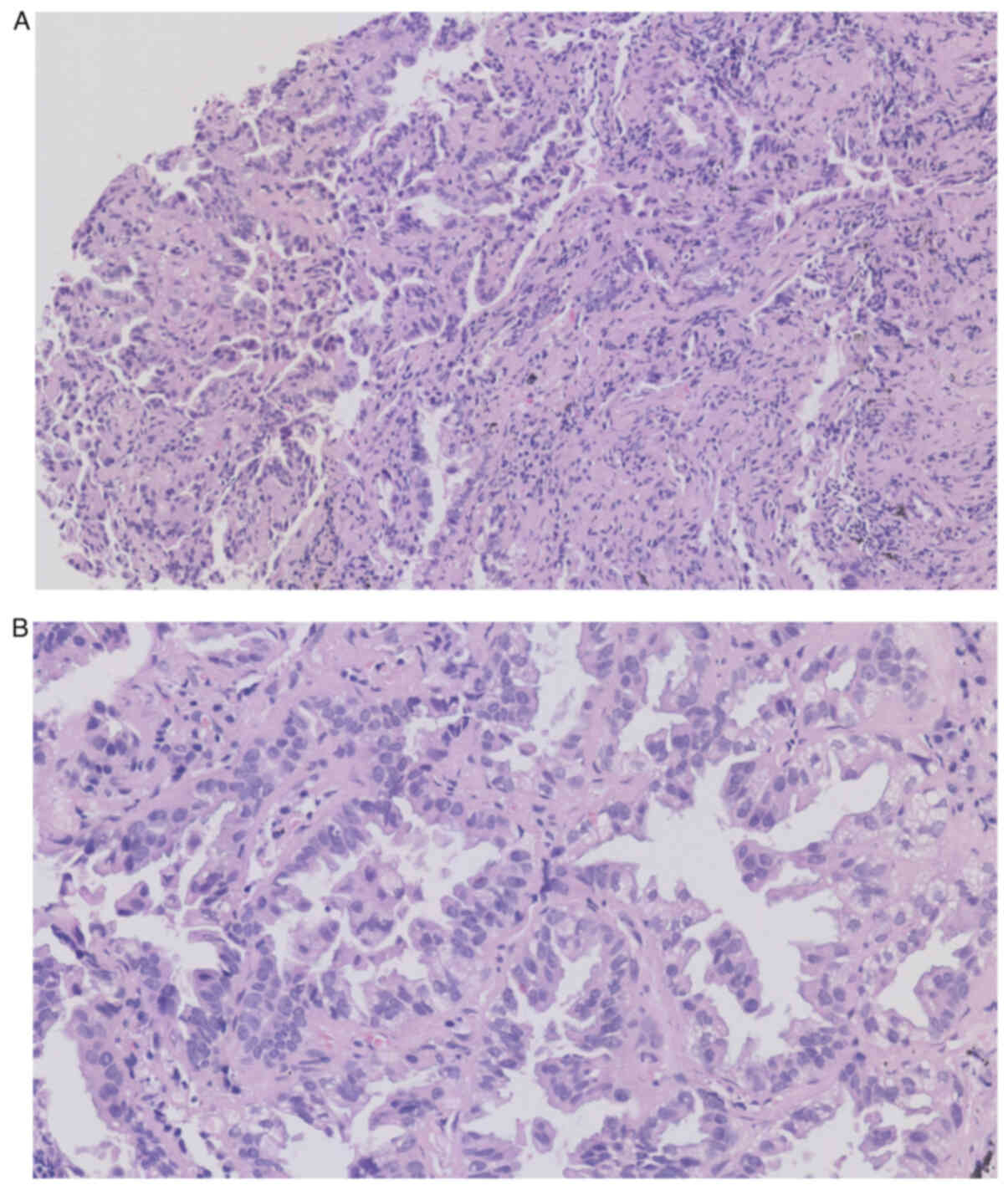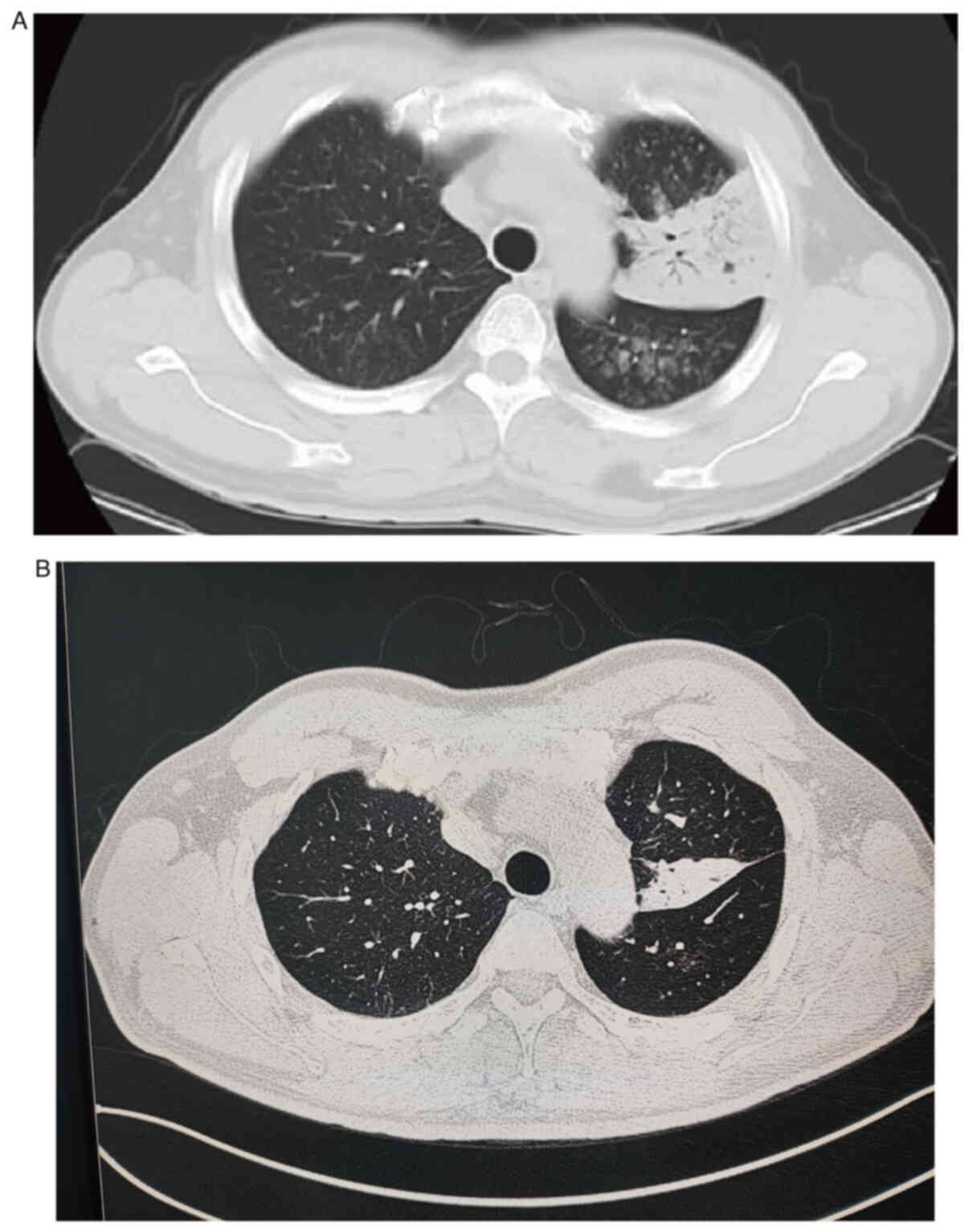Challenges in the differential diagnosis of pulmonary tuberculosis vs. lung cancer: A case report
- Authors:
- Published online on: August 13, 2024 https://doi.org/10.3892/ol.2024.14627
- Article Number: 494
-
Copyright: © Luo et al. This is an open access article distributed under the terms of Creative Commons Attribution License.
Abstract
Introduction
Tuberculosis (TB) is a communicable disease that poses a significant global health burden and represents one of the leading causes of mortality. An estimated 10.6 million people were diagnosed with TB worldwide in 2021, and the TB incidence rate is estimated to have increased by 3.6% between 2020 and 2021. Despite ongoing efforts, the diagnosis of TB remains challenging as existing diagnostic techniques make it difficult to quickly and accurately differentiate TB from other diseases, with a substantial number of cases remaining undetected according to the Global Tuberculosis Report of 2022. Therefore, addressing this issue and improving the TB diagnostic rates are crucial for ending the global TB epidemic (1).
In clinical practice, patients with cancer are occasionally misdiagnosed with pulmonary TB, causing delays in diagnosis and inadequate treatment (2–6). In particular, Kabashi-Muçaj et al (7) previous presented the case of a patient who was treated for TB for ~2 years before being correctly diagnosed with pulmonary mucinous adenocarcinoma, based on positive sputum cytology and transthoracic biopsy results. Similarly, Shu et al (8) analyzed 6,683 misdiagnoses of TB as lung cancer (LC), which were attributed to similar imaging findings (51%) and positive sputum acid-fast staining (27%).
The present case reminds doctors that a positive pathology is the basis for a definitive diagnosis of tuberculosis. A pathogenically negative person who has the symptoms of TB should not immediately be diagnosed with TB in order to avoid misdiagnosis. The patient diagnosis should be made with caution, preferably through discussion by a panel of experts.
Case report
A 59-year-old man was referred to The Third People's Hospital of Zhuhai (Zhuhai, China) in February 2023 with a 6-month history of an unexplained cough and weight loss of 6 kg. The patient had a history of close contact with his father, who had contracted TB 20 years previously. The patient denied smoking but had been consuming alcohol for >20 years primarily in social settings, but without excessive drinking.
Laboratory results showed an elevated C-reactive protein level of 4 mg/l (normal range, 0-10 mg/l) and an erythrocyte sedimentation rate of 7 mm/h (normal range in men, 0-10 mm/h). The IFN-γ release assay (IGRA; cat. no. 20203400710; Livzon Pharmaceutical Group, Inc.) and recombinant Mycobacterium tuberculosis fusion protein (6-kDaA early secreted antigen target/0-kDa culture filtrate protein) tests (EC; cat. no. S20237004; Chongqing Zhifei Biological Products Co., Ltd.) yielded strongly positive results. Chest radiography revealed bilateral pulmonary lesions, particularly on the left lung (Fig. 1). CT revealed multiple patchy, dendritic and small, nodular, high-density shadows in both lungs, particularly in the left lung, which exhibited pulmonary consolidation. Clear bronchial shadows were observed within the lesion, with slight thickening of the pleura adjacent to the left lung lesion (Fig. 2).
After considering the patient's symptoms of coughing and weight loss, coupled with the history of TB contact and the strongly positive results on IGRA and EC tests, pulmonary TB was suspected. The patient was thereby referred to the Department of Tuberculosis within The Third People's Hospital of Zhuhai. However, despite repeated examinations, including a sputum acid-fast bacilli test (cat. no. BA4091; Zhuhai Beso Cell Science and Technology Co., Ltd.) and TB fluorescence quantitative PCR (cat. no. 20153400357; Daan Gene, Co., Ltd.), combined with ineffective anti-infective therapy (days 1-10: 2 g ceftriaxone injection with 0.9% sodium chloride injection 100-ml intravenous drip, every day; 30 mg oral ambroxol hydrochloride dispersible tablets, three times a day; 25 mg oral compound methenamine capsules, three times a day; 3 ml acetylcysteine solution with 3 ml 0.9% sodium chloride injection for inhalation nebuliser, twice per day. Days 8-10: 250 ml 0.4 g moxifloxacin hydrochloride sodium chloride by intravenous drip, every day), a diagnosis of TB could not be established due to the negative results. Elevated levels of the tumor markers neuron-specific enolase (31.20 ng/ml; normal range, 0-16.3 ng/ml) and carcinoembryonic antigen (15.04 ng/ml; normal range, 0-5 ng/ml) were noted, where a detailed review of the chest CT scan suggested that a neoplastic process could not be ruled out. 2-Deoxy2-[18F]fluoro-D-glucose PET combined with low-dose CT (18F-FDG-PET/CT) showed multiple patchy and nodular blurry shadows with highly elevated metabolic activity in both lungs. The bronchial gas phase was primarily observed in the left upper lung, accompanied by partial consolidation and atelectasis. Contrast-enhanced scanning demonstrated enhancement, increased FDG uptake and a maximum standardized uptake value of ~9.3. No significant swelling or radioactive concentration was observed in the bilateral hilar or mediastinal lymph nodes. Pleural effusion was not observed. Moderate focal FDG uptake was observed in the myocardium (Fig. 3). The findings indicative of myocardial involvement were suggestive of metastatic disease. Focal metastasis is an uncommon feature in pulmonary TB. In addition, multiple negative laboratory tests for Mycobacterium tuberculosis provided additional support for the exclusion of TB as a diagnostic possibility. To validate the diagnostic findings, a bronchial section tissue sample was obtained during bronchoscopy and forwarded for histopathological examination. Sections measuring 3-4 µm in thickness were excised and fixed for >10 h at room temperature using 10% neutral-buffered formalin. The sections were then stained with H&E for 40 min at ambient temperature and subsequently examined under a light microscope. DNA was isolated from the tissue samples using the QIAamp DNA FFPE Tissue kit (cat. no. 56404; Qiagen GmbH) following the manufacturer's protocol. PCR was used for the targeted amplification and sequencing of exons 18, 19, 20 and 21, which are known to be frequently mutated in lung cancer, using the Human EGFR Mutation Test Kit (cat. no. 20173404737; Wuhan Haijili Biotechnology Co., Ltd.). The ABI-7500 PCR system (Qiagen GmbH) was used with the following cycling conditions: Initial denaturation at 95°C for 5 min, followed by 15 cycles of 20 sec at 95°C and 30 sec at 62°C, with another 35 cycles of 20 sec at 95°C, 40 sec at 60°C and the fluorescence signal collection at 60°C. Data analysis of amplification results was performed using ABI Sequencing Analysis software version 5.4 (Applied Biosystems; Thermo Fisher Scientific, Inc.) to detect the presence of EGFR mutations. A detailed search was conducted for specific mutations, which found the S768 mutation in exon 20 and the L858R mutation in exon 21. Histopathological examination of the tissue biopsy from the bronchoscopy revealed heterogeneously stained cells with darkly stained nuclei (Fig. 4), which ultimately led to the diagnosis of lung adenocarcinoma.
Due to the fact that The Third People's Hospital of Zhuhai specializes in psychiatric care rather than oncological treatments, the patient was then referred to Zhuhai People's Hospital (Zhuhai, China) for cancer treatment. After 2 months of treatment with oxitinib (80 mg once daily) and bevacizumab (15 mg/kg on day 1) for 21 days per cycle, for a total of 4 cycles, a follow-up CT scan in April 2023 showed a significant reduction in lesion size, indicating a positive response to treatment (Fig. 5). The patient has now been transferred to another hospital to continue treatment.
Discussion
Similarities in clinical symptoms, such as a cough, expectoration and weight loss, couple with those in imaging findings, accounts for the high misdiagnosis rate between TB and certain types of LC, such as lung adenocarcinoma (6). In the present case, in the absence of positive results on the sputum and endoscopic biopsy tests, the initial diagnosis may have been biased by the positive IGRA and EC test results. In addition, whilst PET/CT indicated tumor metastasis, lung CT strongly suggested pulmonary TB. This scenario has frequently resulted in the misdiagnosis of LC as TB, leading to the prescription of TB medications for patients with LC in several countries, such as Iran (9). In the present case, the patient was diagnosed with secondary TB according to clinical criteria and treatment with anti-infective medications was initiated. Given the presence of multiple pulmonary foci, a high probability of identifying a causative agent was anticipated. However, repeated sputum smear examinations and sputum DNA tests for TB were negative. This outcome prompted further diagnostic evaluation. Elevated levels of the tumor markers neuron-specific enolase and carcinoembryonic antigen were noted, where a detailed review of the chest CT scan suggested that a neoplastic process could not be ruled out. Following comprehensive discussions, the patient consented to an electronic bronchoscopy with endoscopic biopsy. The subsequent biopsy pathology results definitively confirmed the diagnosis of lung adenocarcinoma. Histopathological examination of the biopsied tissue provided evidence of a tumor that could have potentially been misdiagnosed as TB.
A review of the relevant literature led to the following key insights: i) TB is frequently found in the apical and posterior segments of the upper lobes, in addition to the dorsal segment of the lower lobes, whereas lung adenocarcinoma is more frequently located in the anterior segment of the upper lobes, the lingual lobe and the dorsal segment of the lower lobes (10). ii) Early coughing associated with lung adenocarcinoma is typically an irritating choking type, accompanied by small amounts of white foamy sputum. Chest pain is typically described as a dull, pressure-like sensation that may be perceived on the same side as the lesion or contralaterally, presenting as a vague, poorly localized discomfort. By contrast, the coughing in TB tends to be ‘moist’, with chest pain occurring on the same side as the lesion, which is persistent, well localized and progressively worsening (11). iii) Hemoptysis in TB is commonly moderate to copious and may resolve rapidly after treatment. Conversely, hemoptysis in lung adenocarcinoma is characterized by small amounts of recurrent and persistent bloody sputum. A single, non-contrast chest CT scan may not provide essential diagnostic cues for clinicians and lacks specificity. This is particularly true for middle-aged and older patients with a history of TB, in which the results can easily mislead the treating physician and result in an incorrect diagnosis. iv) The rapid development of genetic testing technology also provides assistance to clinicians in the differential diagnosis of lung adenocarcinoma and TB (12). A number of studies have shown that the current gene chip detection system can detect 17 types of Mycobacterium tuberculosis, where the detection time is typically 6-8 h and the success rate of Mycobacterium tuberculosis complex identification reaching 100%. By contrast, the success rate of non-TB Mycobacterium tuberculosis identification can reach 95%, which is of great significance for the rapid identification of Mycobacterium tuberculosis (13–15). A previous study showed that EGFR is closely associated with the occurrence and development of lung adenocarcinoma, where its status can also affect the treatment effect. Among patients with lung adenocarcinoma, those with a history of TB are more likely to harbor EGFR gene mutations, especially those on exon 21 (16). In instances where a definitive determination cannot be ascertained, a human EGFR mutation test may be promptly employed for further discernment. In such cases, it is crucial to actively pursue additional diagnostic measures, such as chest enhanced CT and transbronchial biopsy through fiberoptic bronchoscopy to obtain confirmatory evidence. During clinical practice, extra-pulmonary TB is also frequently misdiagnosed as cancer in its early stages, highlighting the diagnostic challenges in both directions (17). It should also be borne in mind that LC and pulmonary TB differ significantly in terms of treatment and prognosis, emphasizing the importance of making an early and accurate distinction (18).
In this case, similarities in clinical symptoms, such as a cough, expectoration and weight loss, and imaging findings, between TB and lung adenocarcinoma led to the misdiagnosis. Therefore, clinicians should consider the possibility of LC in patients with TB-related pulmonary changes on imaging.
Acknowledgements
Not applicable.
Funding
Funding: No funding was received.
Availability of data and materials
The data generated in the present study may be requested from the corresponding author.
Authors' contributions
TL, XL and SZ made substantial contributions to the study conception, collected clinical information and drafted the manuscript. MH made substantial contributions to the design of the study, and writing, reviewing and editing the manuscript. All authors read and approved the final manuscript. TL and SZ confirm the authenticity of all the raw data.
Ethics approval and consent to participate
This case report was conducted in accordance with the guidelines of the Declaration of Helsinki and was approved (approval no. 2023061301) by the Ethics Committee of The Third People's Hospital of Zhuhai (Zhuhai, China). Written informed consent was obtained from the patient.
Patient consent for publication
Written informed consent was obtained from the patient for publication of the data and the images in this case report.
Competing interests
The authors declare that they have no competing interests.
References
|
World Health Organization (WHO), . Global tuberculosis report 2022[EB/OL]. WHO; Geneva: 2022, https://www.who.int/teams/global-tuberculosis-programme/tb-reports/global-tuberculosis-report-2022October 27–2022 | |
|
Silva DR, Valentini DF Jr, Muller AM, de Almeida CP and Dalcin Pde T: Pulmonary tuberculosis and lung cancer: Simultaneous and sequential occurrence. J Brasil Pneumol. 39:484–489. 2013. View Article : Google Scholar : PubMed/NCBI | |
|
Marais BJ, Gie RP, Schaaf HS, Hesseling AC, Obihara CC, Starke JJ, Enarson DA, Donald PR and Beyers N: The natural history of childhood intra-thoracic tuberculosis: A critical review of literature from the pre-chemotherapy era. Int J Tuberc Lung Dis. 8:392–402. 2004.PubMed/NCBI | |
|
Kobashi Y, Fukuda M, Nakata M and Oka M: Coexistence of metastatic lung cancer and pulmonary tuberculosis diagnosed in the same cavity. Int J Clin Oncol. 10:366–370. 2005. View Article : Google Scholar : PubMed/NCBI | |
|
Liang HY, Li XL, Yu XS, Guan P, Yin ZH, He QC and Zhou BS: Facts and fiction of the relationship between preexisting tuberculosis and lung cancer risk: A systematic review. Int J Cancer. 125:2936–2944. 2009. View Article : Google Scholar : PubMed/NCBI | |
|
Bhatt M, Kant S and Bhaskar R: Pulmonary tuberculosis as differential diagnosis of lung cancer. South Asian J Cancer. 1:36–42. 2012. View Article : Google Scholar : PubMed/NCBI | |
|
Kabashi-Muçaj S, Dedushi-Hoti K, Shatri J, Pasha F and Dreshaj D: Pulmonary mucinous adenocarcinoma in the presence of reactivated tuberculosis: A case report. Radiol Case Rep. 16:3647–3651. 2021. View Article : Google Scholar : PubMed/NCBI | |
|
Shu CC, Chang SC, Lai YC, Chang CY, Wei YF and Chen CY: Factors for the early revision of misdiagnosed tuberculosis to lung cancer: A multicenter study in A tuberculosis-prevalent area. J Clin Med. 8:7002019. View Article : Google Scholar : PubMed/NCBI | |
|
Keikha M and Esfahani BN: The relationship between tuberculosis and lung cancer. Adv Biomed Res. 7:582018. View Article : Google Scholar : PubMed/NCBI | |
|
Suárez I, Fünger SM, Kröger S, Rademacher J, Fätkenheuer G and Rybniker J: The diagnosis and treatment of tuberculosis. Dtsch Arztebl Int. 116:729–735. 2019.PubMed/NCBI | |
|
Succony L, Rassl DM, Barker AP, McCaughan FM and Rintoul RC: Adenocarcinoma spectrum lesions of the lung: Detection, pathology and treatment strategies. Cancer Treat Rev. 99:1022372021. View Article : Google Scholar : PubMed/NCBI | |
|
Bloom CI, Graham CM, Berry MP, Rozakeas F, Redford PS, Wang Y, Xu Z, Wilkinson KA, Wilkinson RJ, Kendrick Y, et al: Transcriptional blood signatures distinguish pulmonary tuberculosis, pulmonary sarcoidosis, pneumonias and lung cancers. PLoS One. 8:e706302013. View Article : Google Scholar : PubMed/NCBI | |
|
Fang H, Shangguan Y, Wang H, Ji Z, Shao J, Zhao R, Wang S, Zheng L, Jin X, Huang S, et al: Multicenter evaluation of the biochip assay for rapid detection of mycobacterial isolates in smear-positive specimens. Int J Infect Dis. 81:46–51. 2019. View Article : Google Scholar : PubMed/NCBI | |
|
Wang HY, Bang H, Kim S, Koh WJ and Lee H: Identification of Mycobacterium species in direct respiratory specimens using reverse blot hybridisation assay. Int J Tuberc Lung Dis. 18:1114–1120. 2014. View Article : Google Scholar : PubMed/NCBI | |
|
Zhu L, Jiang G, Wang S, Wang C, Li Q, Yu H, Zhou Y, Zhao B, Huang H, Xing W, et al: Biochip system for rapid and accurate identification of mycobacterial species from isolates and sputum. J Clin Microbiol. 48:3654–3660. 2010. View Article : Google Scholar : PubMed/NCBI | |
|
Ma J, Fang B and Zhang CS: Targeted treatment for advanced lung adenocarcinoma guided by mutations in EGFR exons 19 and 21 in plasma. China Med and Pharm. 14:5–8+46. 2024.(In Chinese). | |
|
Aisenberg GM, Jacobson K, Chemaly RF, Rolston KV, Raad II and Safdar A: Extrapulmonary tuberculosis active infection misdiagnosed as cancer: Mycobacterium tuberculosis disease in patients at a comprehensive cancer center (2001–2005). Cancer. 104:2882–2887. 2005. View Article : Google Scholar : PubMed/NCBI | |
|
Jia H, Zhang L and Wang B: The value of combination analysis of tumor biomarkers for early differentiating diagnosis of lung cancer and pulmonary tuberculosis. Ann Clin Lab Sci. 49:645–649. 2019.PubMed/NCBI |



